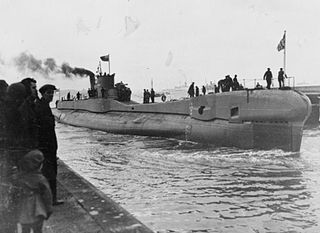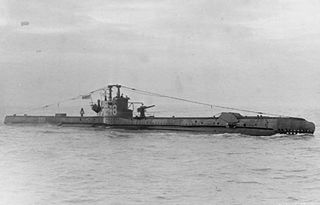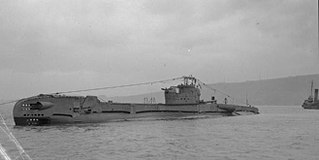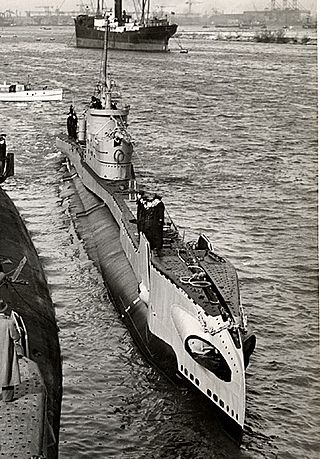
HMS Truculent was a British submarine of the third group of the T-class. She was built as P315 by Vickers Armstrong, Barrow, and launched on 12 September 1942. She sank nine enemy vessels.

HMS Stygian was a S-class submarine of the British Royal Navy, and the only ship so far to bear the name. The boat is listed as being a member of the fourth group, although she had the external stern torpedo tube fitted as in the third group.

HMS Trident was a British T class submarine built by Cammell Laird, Birkenhead. She was laid down on 12 January 1937 and was commissioned on 1 October 1939. HMS Trident was part of the first group of T class submarines.

HMS Seadog was a third-batch S-class submarine built for the Royal Navy during World War II. Completed in September 1942, she spent most of her career in Arctic waters, off Norway, but sank only one German ship in 13 patrols. In January 1945, she was redeployed to the Far East, meeting more success. On her first patrol in the area, the submarine rescued four American airmen. After two patrols, she and her sister ship HMS Shalimar sank five sailing vessels, two coasters, a barge, a tugboat and a Japanese tank landing ship. After the war ended, Seadog was sent back to England, placed in reserve, then sold for scrap in December 1947. She was ultimately broken up in August 1948.

HMS Storm was an S-class submarine of the Royal Navy, and part of the third group built of that class. She was built by Cammell Laird and launched on 18 May 1943. So far, she is the only RN ship to bear the name Storm.

HMS Shalimar was a third-batch S-class submarine built for the Royal Navy during World War II. Completed in April 1944, she conducted one war patrol off the Orkney Islands, then was assigned to the Pacific theater, arriving there in September. The submarine conducted one war patrol off the Nicobar Islands, destroying several small ships with gunfire. During her next three patrols in the Strait of Malacca, Shalimar sank twelve sailing vessels, eleven landing craft, four coasters, three lighters, three tugboats, and one minesweeper. After the war ended, the boat was sent back to England, placed in reserve, then sold for scrap in July 1950.

HMS Statesman (P246) was an S-class submarine of the Royal Navy, and part of the Third Group built of that class. She was built by Cammell Laird and launched on 14 September 1943. So far she has been the only ship of the Royal Navy to bear the name Statesman.

HMS Sturdy was a S-class submarine of the third batch built for the Royal Navy during World War II. She survived the war and was scrapped in 1958.

HMS Rorqual (N74) was a British mine-laying submarine, one of the six ships of the Grampus class of the Royal Navy. She was built by Vickers Armstrong, Barrow and launched 27 July 1936. She served in the Second World War in the Mediterranean and in the far east. She was the only Grampus-class submarine to survive the war, and she is considered the most successful minelaying submarine of World War II, sinking 57,704 GRT of enemy shipping, 35,951 of which through her mines.

HMS Torbay (N79) was a T-class submarine of the Royal Navy. She was laid down at Chatham Dockyard and launched on 9 April 1940.

HMS Thule was a British submarine of the third group of the T class. She was built as P325 at Devonport Dockyard, and launched on 22 October 1942. So far she has been the only ship of the Royal Navy to bear the name Thule, after Thule, the mythological name for a northern island.

The second HMS Telemachus was a British submarine of the third group of the T class. She was built as P321 by Vickers Armstrong, Barrow, and launched on 19 June 1943. She served in Far Eastern waters for most of her wartime career, and was responsible for the sinking of the Japanese submarine I-166. Following the war she was deployed to Australia to operate with the Royal Australian Navy until 1959. She was scrapped in 1961.

HMS Tantalus was a British submarine of the third group of the T class. She was built as P318 by Vickers Armstrong, Barrow, and launched on 24 February 1943. So far she has been the only ship of the Royal Navy to bear the name Tantalus, after the mythological Tantalus, son of Zeus.

HMS Tudor was a British submarine of the third group of the T class. She was built as P326 at Devonport Dockyard, and launched on 23 September 1942. So far she has been the only ship of the Royal Navy to bear the name Tudor, after the Tudor period or Tudor dynasty.

HMS Tantivy was a British submarine of the third group of the T class. It was built as P319 by Vickers Armstrong, Barrow, and launched on 6 April 1943. So far it has been the only ship of the Royal Navy to bear the name Tantivy.

HMS Taciturn was a British submarine of the third group of the T class. built by Vickers Armstrong, Barrow and launched on 7 June 1944. So far she has been the only ship of the Royal Navy to bear the name Taciturn.

HMS Terrapin was a British submarine of the third group of the T class. She was built as P323 by Vickers Armstrong, Barrow and launched on 31 August 1943. So far she has been the only ship of the Royal Navy to bear the name Terrapin, after the animal of that name. Apart from a brief period in home waters off the Scandinavian coast, Terrapin served in the Far East for much of her wartime career.

HMS Tactician was a British submarine of the third group of the T class. She was built as P314 by Vickers-Armstrongs, Barrow, and launched on 29 July 1942.

HMS Taurus was a Second World War T-class submarine, built by Vickers Armstrong, Barrow.

HMS Ultimatum (P34) was a Royal Navy U-class submarine built by Vickers-Armstrong at Barrow-in-Furness, and part of the third group of that class. So far she has been the only ship of the Royal Navy to bear the name Ultimatum.





















